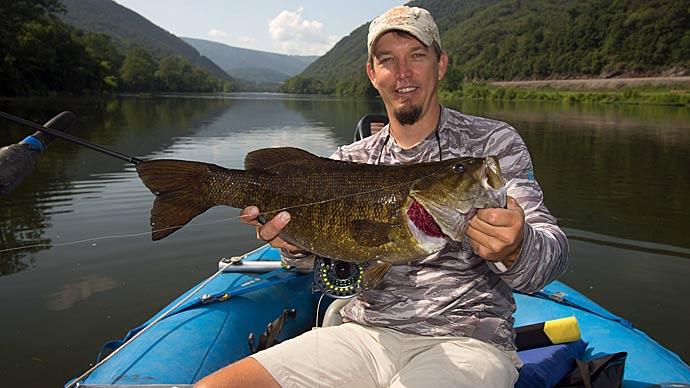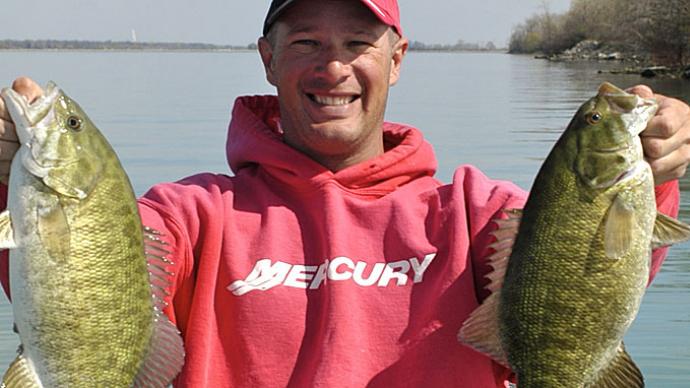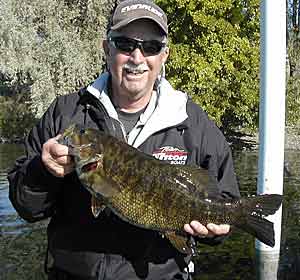
Anglers don’t forget their biggest bass. They recall the details faster than a young child recites their Christmas list in early December. Ask Kennewick, Wash., angler Bob Adkinson, a guide on the Columbia River, about his biggest smallmouth. “I’m not sure about the details,” he’ll likely say with a little grin. Then it all rushes out. It weighed 7 pounds, 5 ounces, measured 22½ inches long, 18 inches around, caught Sept. 3, 2005, in 65-degree water and 14 feet deep, and ate a Big Bite Baits tube jig in Old Ugly color.
About 2,000 miles to the east, Harrison Township, Mich., angler Joe Balog, who’s racked up more than $300,000 by fishing tournaments mostly on central Great Lakes, remembers his top four smallmouth bass. His heaviest was a 7-pound, 1-ounce smallie that ate a hair jig fished on a Lake Erie rock pile in 27 feet of water in December. Then there was the 7-pounder that ate a tube in a mix of weeds and sand in 10 feet of water on Lake St. Clair in October; the 6-pound and 13-ounce one that came off a 6-foot-deep rock pile in New York’s Chautauqua Lake in October on a jig-and-chunk and the 6-pound and 12-ounce smallmouth he caught off a 4-foot-deep rock pile on Lake St. Clair in May. He caught that one on a Goby Replica swimbait.
Adkinson and Balog are not alone. Every angler remembers their biggest smallmouth. Those catches are hard to forget. The fish pull hard, jump high, and plaster smiles on their faces. Adkinson sums it up best. “The fight you get from a smallmouth bass is unbelievable,” he said. “You catch a 2-pounder and think you have a 4-pounder.”
Five-pound smallies are nice ones. But when they pull down a scale to 6 or 7 pounds, it’s a giant smallmouth. Those are the ones bragged about and remembered for lifetimes—anglers who have not caught one that big want to.
So how do you catch the smallie whose picture will be the background on every cellphone you will ever own? According to Adkinson and Balog, catching one takes the good lake, spot, gear, and understanding of how these big smallies behave. The game changes when you want to catch a giant.
Adkinson and Balog know that game better than most anglers. Their home waters are some of the top smallmouth fisheries in the country. The Columbia and Lake St. Clair, the shallow dish-shaped lake between Huron and Erie, are in the top 20 of Bassmaster magazine's 100 Best Bass Lakes list for 2014. Their knowledge and insight will set the playing field. It’s up to you to execute.
Pick the best water
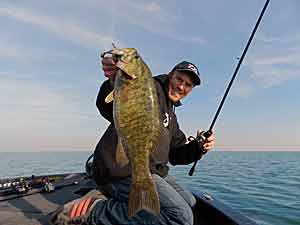
Dania Beach, the Fla.-based International Game Fish Association, says the biggest smallmouth was caught in Tennessee’s Dale Hollow Lake in 1955. It weighed 11 pounds and 15 ounces. A Wisconsin angler caught one shy of 8½ pounds from Sturgeon Bay on Lake Michigan in 2013. The native range for smallmouth bass extends from the Great Lakes basin south to Tennessee and Arkansas. They’ve been introduced from coast to coast in the U.S.; the deep Southeast is the only region without any. Many lakes, rivers, and streams have smallies, but not all have giants.
“I firmly believe the best body of water for the biggest smallmouth in the country is the Western Basin of Lake Erie — from Avon, Ohio, to Detroit,” said Balog, who has had his entire life to verify that statement. His father sailed a charter boat on Lake Erie, and his uncles fished it. He didn’t have a choice but to join them. The Great Lakes are so large and the schools of smallies so big that they seem endless.
“Today, however, we are learning that the world is shrinking,” he said. “Larger boats and better electronics have made us realize that we can pressure the fish tremendously. St. Clair is a prime example. The fishing isn’t half of what it was a decade ago. But the big waters still have that draw.”
“Big smallies need big bodies of water,” Balog said. “Smallmouth get big in some rivers, but most fish spend at least part of their time feeding in lakes.” In some waters, the biggest smallmouth will spawn in a lake, but as the water temperature rises, they move into a tributary.
“They love current in the summer,” he said. “But they’ll move back to the lake in late fall because, in winter, they avoid current, from what we know.” Smallies aren’t afraid to swim. In the Great lakes, they move long distances. “It’s never been proven through study, but I believe we will someday see studies that confirm many smallmouth in the big systems — such as Lake Erie, Lake Ontario, Lake St. Clair, Lake Michigan, and Lake Champlain — move 20 to 30 miles from spring through fall,” he said. “We see it here. The fish are on the west side of the lake in spring and the east side in fall. They’re 25 miles from each other. It’s not a big deal to the bass. They’ve lived here a lot longer than we have.”
Adkinson was discharged from the Marine Corps in 1965, and he’s been fishing for bass ever since. He fished the B.A.S.S. Western Opens and other tournaments in the West. He started Atkinson’s Guide Service in 2002 and specialized in smallmouth on the Columbia River.
“Right below McNary Dam is where I spend most of my time,” he said. “If I want to go for big smallmouth, I fish the Hanford Reach.” It’s the last free-flowing stretch of the Columbia and not an easy place to fish. “It’s narrow, shallow, and the current moves fast. But it holds some big, big smallmouth.”
Those hurdles keep many anglers from jumping in their boats and fishing the Reach. That reduces pressure, helping smallies grow big and more willing to eat lures. It’s similar to the Great Lakes, where fishing pressure is diluted by acre after acre of water.
Fish the best times
Anytime is a good time to go fishing, but not every time is an excellent time to catch a giant smallmouth. On the Columbia, Adkinson catches his biggest smallies during the spring — before and during spawn — and fall. In the fall, he said, smallmouth are eating machines, cashing in on large runs of shad, and packing on pounds for winter. He’ll catch big smallies in the winter but only on occasion. He said their metabolism and appetites are slowed by the cold, making them tougher to catch.
Balog is in the same boat. “We have always caught the biggest, heaviest fish on Erie from March 20 to April 15,” he said, adding the water temperature in the 40s. The bite there also peaks in late fall. “I’ve always theorized that the biggest fish eat the most, and they continue to feed all winter to support their size,” he said.
Fish the correct gear
You need to prepare your gear for giant smallmouths, whose name can misdirect anglers toward tiny tackle. “You don’t want rods labeled ‘smallmouth rods,’ which are just crappie rods,” Balog said. “You want big, long rods regardless of action.” He never uses a rod less than 7 feet; most in his rod locker are 7½ feet. Longer rods control hooked smallmouth better. They also help keep them hooked when they jump, and they will jump. All of his rods are graphite, even the ones for crankbaits. Fiberglass rods lack the backbone to drive crankbait hooks home.
“I use a Daiwa Tatula 7-foot, 7-inch medium-action graphite rod for that application.” And use it he did at the B.A.S.S. Northern Open on Lake St. Clair in early September 2014. He cranked up five-fish limits of smallies that weighed 22 pounds and 8 ounces and 25 pounds and 2 ounces on days 1 and 2, respectively. That was enough to keep him in first both days. Unfortunately, on the last day, his outboard broke. Once he restarted in a replacement boat, he had only enough time to catch 8 pounds and 3 ounces. He still finished seventh.
In fall, when Adkinson thinks he has the best chance to catch a giant river smallie, the Columbia runs clear. Less rain falls during the summer, which means less runoff to stain its water. To counteract that, he spools his Shimano reels with 10- or 12-pound test fluorocarbon line. It has the same refractive index as water, so light passes through both similarly. That makes fluorocarbon line invisible underwater. It helps generate bites because smallies, especially larger ones with more years of conditioning, are extra wary in low and clear water.
Adkinson uses several soft-plastic lures to chase giant smallies, including the tube he caught his biggest on and Bass Kickin’ Baits’ Thug, which is soft stick bait. He fishes Thugs weightless, letting them wash along current breaks. He inserts a teardrop jig head — 1/8- or 3/16-ounce, depending on current and depth — into the tubes. In the fall, he’ll add a larger profile jig-n-pig or buzzbait, which mimics the shad.
While Balog says no to wimpy rods, he says yes to subtle lures for big smallies, which, except in rare circumstances, ignore flashy and gaudy lures such as spinnerbaits. The lures he has caught the most 6-pound or bigger smallies on are, starting with the best: tubes, drop-shot baits of various sizes and colors, hair jigs, the Goby Replica swimbait, traditional bass and football jigs, and crankbaits.
Anglers will recognize all of those lures, except maybe the fourth one, which Balog designed in 2003. It had been about ten years since gobies, the European baitfish that ocean-going vessels discharged into the Great Lakes along with their ballast water, had arrived. He had worked on goby imitators for drop-shotting and found some success, but he wanted a closer match. The Goby Replica’s moving fins and big weight keep it upright and on the bottom, just like the real thing.
Fish like big smallies think.
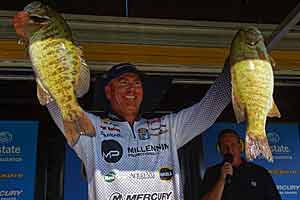
If you pull up on the spot and start catching 3-pound smallies on every cast, Balog said it’s time to move. “Giant smallmouth relate in small packs, not the big schools,” he said. “If you’re catching 3-pounder after 3-pounder, you’re not by giant smallmouth.” You must also be around big bait — crawfish, perch, gobies. He said that giant smallies eat, except in spring when they are more likely to feed on small baitfish.
Seasonal movements, such as shallow-to-spawn in spring, dictate smallmouth movement over the year. On a day-to-day basis, they react to water and weather conditions. Adkinson catches his best smallies on overcast days when a slight breeze blows. Balog agrees: “Wind is usually good wherever you fish.” But the best sky condition is more local. “Around St Clair, we like sunny days — it seems to charge the fish up to feed.”
Fish the best spot
So you’ve researched and dropped some money at your favorite tackle shop. You’ve found the proper lake, and you’re not messing with 3-pounders, which is easier said than done. You’re ready to catch your biggest smallmouth. So, where do you make your first cast? Balog said near deep water.
“If a structural area is going to attract huge smallmouth, it’s not going to be way up on a flat, a mile from deep water,” Balog said. “It must have a direct pathway to the main, open lake. That might just be a weed edge in 15 feet of water or a rock pile in 40. But somewhere, close to where that fish lives, there’s an ‘out’ that takes it to the abyss.” With that structure located, you need to find the cover on it. That’s a function of each lake or river. “If a lake has a lot of grass, like St. Clair, it would be weed clumps or edges in the main lake.”
On the narrower confines of the Columbia River, giant smallies live by another force. “Current is critical,” Adkinson said. “That big one I caught was on an island point.” He looks for seams, where fast water meets slow, caused by shoals, points, and islands. Smallies hold in the slack water, waiting to dart in the swift water when a meal washes. Current also concentrates them, making it easier for anglers to pinpoint them. Smallies scatter as the current slows, forcing anglers to fish more water.
Make a memory
It won’t be an easy game to master. Catching a giant smallie takes time and a unique strategy. Anglers must focus on the specific need of big smallies, even if that means shunning the fun of 2-pounders that feel like 4-pounders. When you do catch a giant, you’ll never forget it. Take many photos, then put it back, so its unique genetics can be passed on. And it’ll be there to catch again when it’s bigger.


